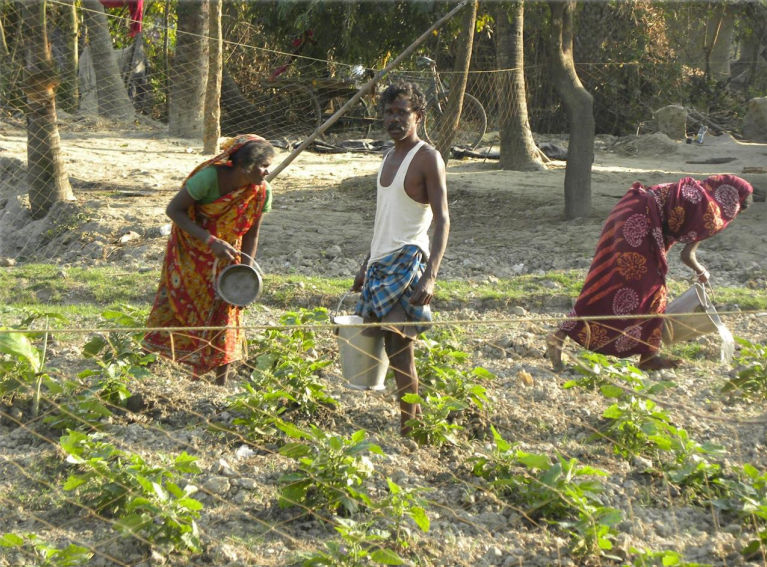






In the fragile, flood and cyclone ravaged Sundarbans, where saline waters erode more than just land, communities have been grappling with vanishing livelihoods and worsening food insecurity. Yet amidst this uncertainty, a quiet change is underway — led by marginal and tribal farmers who are now reaping resilience with SEED’s Climate-Smart Livelihood initiatives.
Sahashya Sphiti: Mustard Revolution in Transitional Agro-Ecologies
In the transitional agro-climatic zones of Nadia district, where erratic rainfall and pest attacks made mono-cropping unsustainable, SEED introduced Swarnadhara mustard seeds to over 600 marginal tribal farmers. Swarnadhara mustard thrives in Nadia’s lateritic soils and erratic rainfall (900–1,100mm/year). Farmers like Mamata Bhuinya, Supriya Mondal, Mangal Mahato and Ramshankar Das embraced climate-resilient mustard farming after training in organic inputs, pest management and market linkage.
These mustard fields now thrive across 400 acres, bringing a 40% increase in productivity and reviving the once-fallow land. With reduced input costs and improved soil health, these farmers now enjoy better incomes, food security and bargaining power at markets. The story of Supriya Mondal, who almost leased her land out due to losses, now inspires others in the community to return to climate reselient farming with confidence.
“I had stopped farming after two consecutive losses due to pests and floods,” says Supriya Mondal, holding a fresh bunch of mustard greens with visible pride. “We were about to lease our land when SEED came to our village.”
Nadia’s transitional agro-ecological zones have long suffered the twin curses of erratic rainfall and economic fragility. Mono-cropping paddy or jute had become a gamble with each passing season, pushing marginal tribal farmers into debt traps and seasonal migration.
Through targeted training, SEED introduced climate-resilient mustard varieties like Swarnadhara, designed to thrive with less water and resist pests. The project also taught farmers to make their own bio-pesticides, vermicompost, and mulch — shifting from dependence on costly chemicals to organic, low-cost alternatives.
Greening Salty Soils: Organic Betel and Bio-Farming in Sagardwip
In the saline-affected lands of Sagardwip, SEED trained 1,425 farmers in organic betel leaf cultivation under the World Bank-funded ICZM project. Beneficiaries like Krishna Maity and Bimal Mondal adopted vermicomposting and bio-pesticides, reducing chemical inputs by 35%. Precision agriculture techniques introduced by SEED not only improved yields by 20% but also protected soil health against saline intrusion.
‘We’ve moved from fear of crop loss to confidence in each harvest,’ says Krishna, whose family now sees consistent income from their organic plot.
Seeds of Resistance: Salt-Tolerant Paddy & Vegetable Cultivation
In the cyclone-ravaged Patharprotima block, 550 smallholder farmers received salt-tolerant seed varieties. Names like Arun Bera, Ganesh Samanta and Tapasi Halder now stand for change as they tend to lush paddy fields that once yielded nothing.
Crop losses have dropped by 45% thanks to water-smart practices and seed bank systems introduced in 10 villages. ‘Even after last year’s saline flood, we harvested enough to feed and sell,’ shares Tapasi, standing in her green paddy field.
Growing Gardens on a Sinking Island: Horticulture in Ghoramara
On erosion-prone Ghoramara Island, SEED distributed fruit saplings and horticulture kits to 275 households. Beneficiaries like Ganga Mondal, Rina Das, and Radha Sardar created vibrant backyard gardens in 7 villages. For islanders battling sea-level rise, this initiative brought food security.
‘Now my children eat fruits from our own garden. We even sell surplus in the market,’ says Radha from Raypara village, smiling next to her guava tree.
SHGs Sprouting Strength: Women-led Livelihoods Across Sundarbans
With support from NABARD, SEED mobilized 18,000 women across 9 blocks into 1,550 SHGs. Women like Purnima Bera and Nilima Sardar now manage goatery, poultry and micro-enterprises. These initiatives increased their income by 25% and significantly enhanced their decision-making power.
‘Earlier, we waited for our husbands to send money. Now we contribute equally,’ says Nilima, who also trains others in poultry care.
Reviving Wetlands, Reviving Lives: Sustainable Aquaculture in East Kolkata
In the sewage-fed canals of East Kolkata Wetlands, SEED introduced eco-friendly bamboo pen culture for catfish breeding. 300 fish farmers, including tribal youth like Ranjan Das and Pradip Mahato, now earn steady incomes and contribute to ecological restoration by releasing 20% of fingerlings into local water bodies.
‘This isn’t just fish farming. It’s our fight against forced migration,’ says Ranjan, as he prepares to scale up his aquaculture unit.
A quiet yet powerful transformation
SEED’s climate-smart agriculture interventions have turned fragile geographies into fertile possibilities. With over 20,000 farmers empowered across six landmark projects, the Sundarbans are witnessing a quiet yet powerful transformation — one that’s rooted in soil, supported by science and led by its own people.
SEED's agricultural interventions are rigorously designed in accordance with ICAR's climate-resilient farming guidelines, CSSRI's saline agriculture protocols, and NABARD's sustainable livelihood frameworks for eastern India. Our crop selections and cultivation techniques undergo thorough verification against CSSRI's latest research on salt-tolerant varieties and agroecological best practices before implementation.



Subscribe to the SEED Newsletter — and be part of the change!